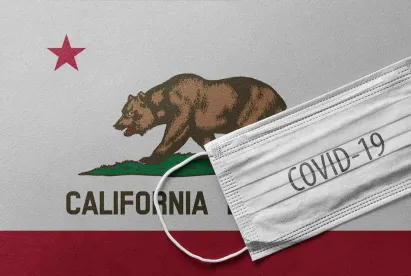Late last week, in an effort to control the increase of COVID-19 cases and stabilize the overwhelming hospital systems,[1] California Governor Gavin Newsom announced a new Regional Stay At Home Order (December Order) based on Intensive Care Unit (ICU) bed capacity. Under the December Order, if the available ICU capacity dips below 15% in any of the 5 designated regions, said region will be placed into a stay-at-home order. Such order will go into effect at 11:59 p.m. following the day the region hits the ICU threshold, and will continue until the region’s total available adult ICU bed capacity is greater than or equal to 15% projected over 4 weeks. If the December Order is in effect in a region, it supersedes any conflicting terms in other California Department of Public Health order, directive or guidance. Once the stay-at-home order lifts for any impacted region, the December Order will no longer apply and each county in said region will be assigned to a tier based on the Blueprint for a Safer Economy.
As of Newsom’s announcement, the December Order has gone into effect in Southern California and San Joaquin Valley. Although the December Order has not gone into effect in the Bay Area region, San Francisco, Santa Clara County, Contra Costa County, Alameda County, Marin County, and the City of Berkeley have decided to implement the December Order ahead of schedule.
The actual capacities for each region are as follows:[2]
| REGION | |
| Northern California | 28.2% |
| Bay Area | 25.7% |
| Greater Sacramento | 20.3% |
| San Joaquin Valley | 6.3% |
| Southern California | 10.9% |
Under the December Order, if ICU capacity dips below the 15% threshold, the following mandates will apply:
-
All gatherings with members of other households are prohibited.
-
All individuals living in the region shall stay home or at their place of residence except as necessary to conduct activities associated with the operation, maintenance, or usage of critical infrastructure, as required by law, or as specifically permitted in the December Order.
-
Critical infrastructure sectors may operate and must continue to modify operations pursuant to the applicable sector guidance. This includes functions critical to public health and safety, as well as economic and national security.[3]
-
The December Order does not modify existing state guidance regarding K-12 schools. Schools that have previously reopened for in-person instruction may remain open, and schools may continue to bring students back for in-person instruction under the Elementary School Waiver Process or Cohorting Guidance.
-
Worship and political expression will be permitted outdoors, in accordance with existing guidance for those activities.
-
All retailers may operate indoors at no more than 20% capacity and must follow industry guidance for retailers. Stand-alone grocery stores, where the principal business activity is the sale of food, may operate at 35% of capacity (based on fire department occupancy limits).[4]
-
No hotel or lodging entity shall accept or honor out of state reservations for non-essential travel, unless the reservation is for at least the minimum time period required for quarantine and the persons identified in the reservation will quarantine in the hotel or lodging entity until after that time period has expired.
-
Offices must remain remote only except for critical infrastructure sectors where remote working is not possible.
The December Order took effect at 12:59 p.m. on Saturday, December 5th.
Impacts to Real Estate Development
Similar to Governor Newsom’s March executive order (EO N-33-20),[5] the December Order states, “[c]ritical infrastructure sectors may operate and must continue to modify operations pursuant to the applicable sector guidance.” In accordance with the December Order, the State Public Health Officer has designated the following list of Essential Critical Infrastructure Workers to help state, local, tribal, and industry partners as they work to protect communities, while ensuring continuity of functions critical to public health and safety, as well as economic and national security.
Section 13 of the Essential Critical Infrastructure Workers list (Industrial, Commercial, Residential and Sheltering Facilities and Services) allows for continued development and construction of a myriad of project product types, including housing, commercial, and mixed-use. Among other development-related jobs, Section 13 also allows specialty service providers (carpenters, plumber, electricians, etc.), workers who support the building material supply chain, property management, leasing employees and real estate agents to continue on-site operations that cannot be done remotely.
As you are aware, things are changing quickly and the aid measures and interpretations described here may change and are subject to wide interpretations. This article represents our best understanding and interpretation based on where things currently stand and is not intended to address all potential legal risks or to be a definitive statement of law.
FOOTNOTES
[1] The number of new hospital admissions have dramatically increased from 777 on November 15th to 1,651 on December 2nd. CDPH stated that without additional intervention the number of available ICU beds in the State of California are expected to be at capacity by mid-December.
[2] See https://covid19.ca.gov/stay-home-except-for-essential-needs/.
[3] https://covid19.ca.gov/industry-guidance/
[4] Supplement to Regional Stay At Home Order (ca.gov)
[5] On March 19, 2020, Governor Newsom issued EO N-33-20 directing all residents to immediately heed current State public health directives to stay home, except as needed to maintain continuity of operations of essential critical infrastructure sectors and additional sectors as the State Public Health Officer may designate as critical to protect health and well-being of all Californians. See here for a prior article on EO N-33-20.



 />i
/>i
